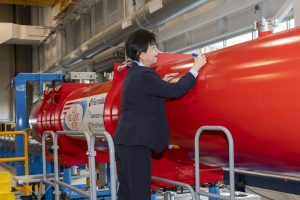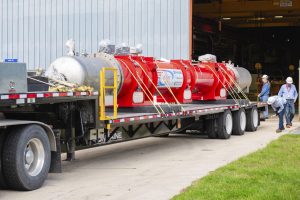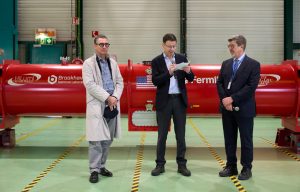On Dec. 18, the physics laboratory CERN in Geneva, Switzerland, celebrated the arrival of a very large parcel from the United States. Inside was a 13-meter-long assembly comprising two magnets with 4.2-meter-long coils. These are the first U.S.-built magnets for the high-luminosity upgrade to the Large Hadron Collider. Over the next few years, another nine assemblies will follow, thus completing a two-decades’ effort by a consortium of U.S. Department of Energy national laboratories—Fermilab, Brookhaven and Berkeley—to design and build new accelerator focusing magnets. These magnets, along with those from CERN, will be installed around two of the LHC’s collision points in two years’ time.
“In the realm of large scientific endeavors like the HL-LHC, global collaboration and expertise play pivotal roles. The delivery of the first cryo-assembly housing fully validated niobium–tin series magnets is a tangible testament to the success of the U.S. Accelerator Upgrade Project,” said Mike Lamont, CERN director for accelerators and technology. “This event not only marks a crucial milestone in our collaboration with our U.S. partners, but also celebrates the outstanding contributions shaping the future landscape of particle physics at CERN.”
The Large Hadron Collider smashes protons and other atomic nuclei together at close to the speed of light, recreating conditions that existed shortly after the Big Bang. Scientists study these collisions to learn about subatomic particles and the fundamental laws of physics. They look for answers to some of the biggest questions in physics. What is the nature of dark matter? What happened to all the antimatter? How did particles acquire mass during the early universe?
The magnets built by the U.S. HL-LHC Accelerator Upgrade Project will tightly squeeze the two proton beams traveling in opposite directions around the LHC just before they collide. This tight squeeze will contribute to increasing the LHC’s collision rate by a factor of 5 over the original design value. Together with other upgrades, it will allow scientists to collect more data much faster than ever before. With these huge data sets, scientists will be able to study extremely rare subatomic events with high precision and explore phenomena beyond what the current LHC capabilities allow.

Harriet Kung, deputy director for science programs in the DOE’s Office of Science, signs the first U.S. magnet assembly for the high-luminosity upgrade to the Large Hadron Collider in October. Photo: Dan Svoboda, Fermilab
Upgrading the collision rate is no easy feat. Scientists needed to create magnets that are strong enough to focus and squeeze the proton beams of the LHC into much tighter bunches as they collide head on. So how are they doing it?
The answer is a rarely used and fussy superconducting material called niobium-3-tin, or Nb3Sn. When cooled with liquid helium to minus 271.25 degrees Celsius, Nb3Sn is an excellent superconductor and transports electricity without resistance. It is a type of superconductor that can reach higher magnetic fields than the standard niobium-titanium currently used in LHC superconducting magnets. The new magnets produce a maximum magnetic field of 12 tesla, roughly 50% more than the strength of the niobium-titanium focusing magnets currently in the Large Hadron Collider.
Scientists had never used Nb3Sn in a large-scale accelerator project because it is extremely difficult to work with.
“It’s brittle like glass,” said Giorgio Apollinari, the head of the HL-LHC accelerator upgrade project at the U.S. Department of Energy’s Fermi National Accelerator Laboratory. “When properly handled, glass can last for centuries, like in a cathedral window, but then one day you knock it, and it breaks. We spent a lot of time figuring out how to treat and handle this material and address its brittleness.”
In 2003, the U.S. Department of Energy established the LHC Accelerator Research Program to explore the properties of Nb3Sn and figure out how to incorporate it into accelerator magnets. By 2015, scientists at participating labs were ready to move to production. The first HL-LHC cryo-assembly was completed in 2022 and successfully passed testing at Fermilab in 2023.
“Designing, building and successfully testing these advanced Nb3Sn magnets with accelerator-quality features is a first for humanity and represents a major progress in accelerator technology,” said Apollinari. “But this initial success is only part of the story.”
Shipping magnets and their components among the US laboratories has been a backbone of the upgrade project. But according to Apollinari, safely sending a 25-ton cryo-assembly around the world is a challenge. “You can’t just go to the store and buy Styrofoam or bubble wrap to package it for shipment,” he said.

This 13-meter-long assembly for the HL-LHC upgrade comprises two 5-meter-long superconducting magnets. It was shipped from Fermilab to CERN. Photo: Ryan Postel, Fermilab.
The magnet needed to arrive at CERN in mint-condition and incur no damage during the transit. So the magnet team started as any good scientific team would: with a dummy-magnet made from 25 tons of concrete and iron, and loaded with sensors.
“We drove a block of concrete around the U.S. and then sent it by ship to CERN,” Apollinari said. “The sensors were so good that we could tell when the truck was going over railroad tracks.”
From this data, they were able to design shipping equipment—their special version of “bubble wrap”—and a shipment plan that took into account how much force and acceleration the magnet could tolerate from the turbulence the magnet might experience during its journey.

CERN celebrated the arrival of the first cryo-assembly for the HL-LHC with a ceremony on Dec. 18. From left: Oliver Brüning, CERN, HL-LHC project leader; Mike Lamont, CERN, director for accelerators and technology; and Giorgio Apollinari, Fermilab, head of the U.S. HL-LHC Accelerator Upgrade Project. Photo: CERN
After one month on land and at sea, the real magnet finally arrived at CERN in November 2023, where it is currently being evaluated. Eventually, CERN personnel will install this magnet—along with 7 more from the United States and 8 from CERN—100 meters underground in the LHC tunnel to focus the particle beams approaching the collision points of the two largest LHC experiments: ATLAS and CMS. The HL-LHC installation will start in 2025, with the plan to start colliding protons with the upgraded machine in 2029.
Said HL-LHC project leader Oliver Brüning, CERN: “The arrival of this first cold-mass assembly marks the start of a new phase of the CERN-US collaboration: the delivery of final cryo-assemblies ready for the installation in the LHC.”
Fermi National Accelerator Laboratory is supported by the Office of Science of the U.S. Department of Energy. The Office of Science is the single largest supporter of basic research in the physical sciences in the United States and is working to address some of the most pressing challenges of our time. For more information, please visit science.energy.gov
